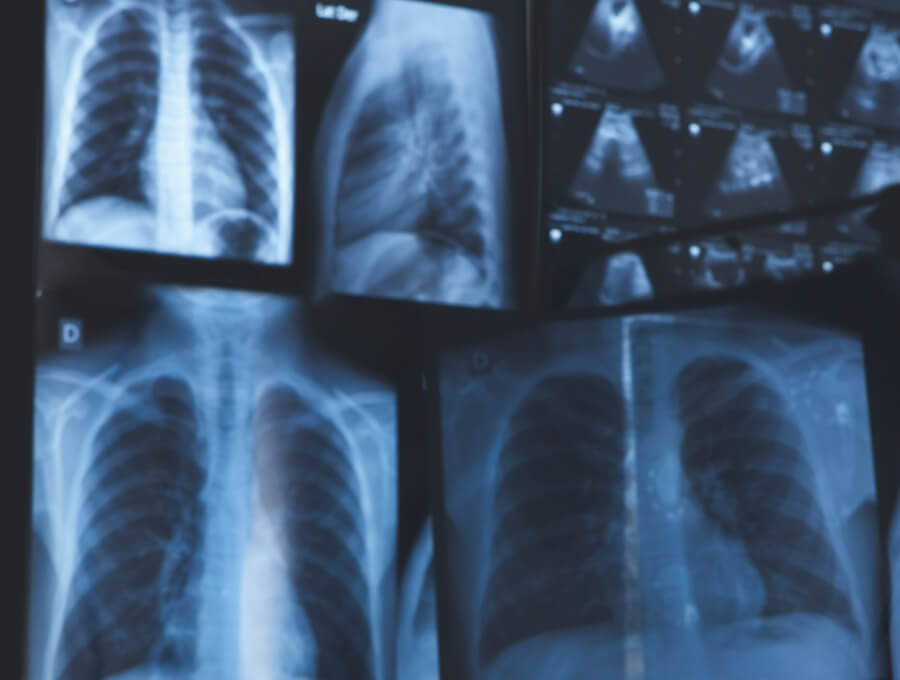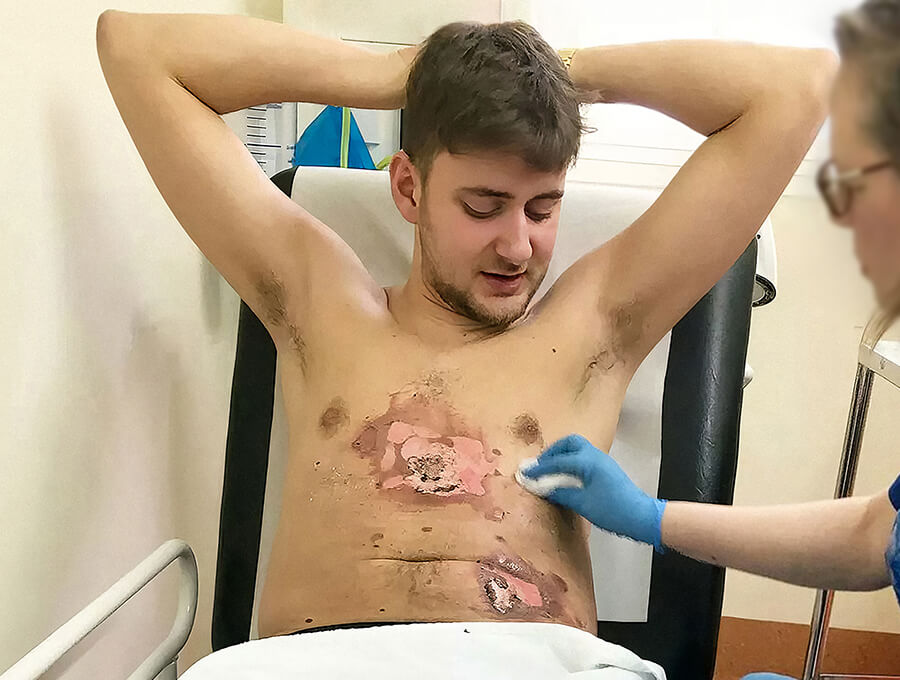FACTS ON VAPING HARMS
Vapes are proven to cause real harm. The evidence on the health harms of vaping is growing.
Find out more about the toxic chemicals in vapes and the known harm they cause.

Facts on vaping harms
Research shows that vaping allows tiny particles to be inhaled deep into the lungs. These tiny particles spread and settle throughout the airways. Here these chemicals can cause inflammation, cell death, scarring and DNA damage.
Experts are very concerned about flavouring chemicals found in vapes. These have been linked to ‘popcorn lung’ (bronchiolitis obliterans). They can cause inflammation, permanent damage and scarring in the small branches and airways in lungs.
Vapes also contain other chemicals that are toxic to lungs. For example, chlorine (found in disinfectant) and acrolein (found in weed killer).
Doctors and lung experts in NSW have seen people who vape needing hospital treatment for breathing issues and lung damage.


It’s a myth that when you vape, it’s just water vapour you’re breathing in. Research shows that the vapour can contain hundreds of toxic chemicals. As well as heavy metals, like lead, nickel, chromium and iron.
Here just a few of these toxic chemicals that scientists have found in vapes:
- Formaldehyde – Used in disinfectant and known to cause cancer.
- Chlorine – Found in disinfectant and known to cause lung damage.
- Benzene – Used in bug spray and known to damage DNA.
- Mercury – Found in batteries and known to damage fertility.
- Acrolein – Used in weed killer and known to be toxic to the heart and lungs.
- Arsenic – Used in poisons and known to damage internal organs.
Want to know more about the harmful chemicals found in vapes? View this key report (PDF) listing them and their harms.
Nicotine is one of the most addictive substances ever known. The majority of vapes contain high levels of nicotine, even when they don’t list it on the label. Nicotine can harm the parts of the brain that affect attention, learning, mood and impulse control.
Research shows that every time you vape, nicotine quickly absorbs into your body and reaches your brain within seconds. Here it causes an excessive release of dopamine, a chemical that can make you feel good for a little while. This flood of dopamine is unnatural and is what causes addiction. Within a few hours of vaping, people feel withdrawal symptoms. These include irritability, anxiety, anger, difficulty staying focused and impatience.


Vapes contain a number of toxic chemicals, such as diacetyl, that can cause inflammation of the lungs. This decreases your oxygen – making it harder to breathe. These dangerous chemicals have been proven to permanently damage your lungs.
Initial symptoms that vaping is causing damage to your lungs can include coughing, wheezing, chest pain or shortness of breath. If you have these symptoms and want help to quit, head to the quit vaping section.
We all know cigarettes cause cancer. It’s been proven for years now. And yet every time you vape, you’re inhaling a lot of the same cancer-causing toxins that are in cigarettes.
Some of the chemicals found in vapes that are known to cause cancer include: formaldehyde, arsenic, acrolein, benzene, nickel, and toluene, just to name a few.
That’s not even including all the other toxic chemicals that are proven to damage internal organs or be potentially fatal if inhaled. For example, cadmium, benzaldehyde, crotonaldehyde and dimethylnitrosoamine.
The long-term harms from exposure to these chemicals won’t be known for many years. But we know that the risk of harm by being exposed to these chemicals is increased by frequent vaping over a period of time.


Vapes are basically a pod with chemicals and batteries which heat the liquid to create a vapour. There are many reports of vapes exploding or catching fire. They can cause severe burns, often to the face, hands, thighs, chest and genitals. This happens when they explode in people’s hands, pockets or mouths. Vapes can also cause injuries where the parts of the exploding device can be embedded into parts of the body.
Vape explosions are likely to be caused by the battery short circuiting. This can be because they get too hot, get wet, incorrect charging or battery damage.
Nicotine is highly toxic and is classified as a poison. The majority of vapes contain high levels of nicotine, even when they don’t list it on the label. Many people who vape have experienced feeling ‘nic sick’. The symptoms of nicotine poisoning include coughing, nausea, headaches, dizziness, diarrhoea, increased heart rate and vomiting. And, in extreme cases, seizures and passing out. This is why vapes should always be kept out of reach of young children as they can cause serious poisonings.
Concerned someone has nicotine poisoning?
- If they have stopped breathing or collapsed call 000.
- For information and support call the NSW Poisons Information Line on 13 1126.

REAL STORIES OF VAPING HARMS
These stories are from real people who used to vape and have suffered health issues and real vaping harms. See why they’re determined to never vape again.
EXPLORE QUIT VAPING SUPPORT
Quit vaping apps

There are apps you can download to help you quit vaping. These apps can help you track your progress, connect with others who are quitting, and cope with cravings.
Note: The apps listed here are not operated by the Cancer Institute NSW or NSW Health and charges may apply.
The Cancer Institute NSW commissioned an independent review of publicly available quit vaping apps on the Apple App Store and Google Play Store in May 2023. The apps were reviewed and assessed against established assessment tools for quality and behaviour change potential. These apps were assessed to have at least moderate levels of quality and some evidence of behaviour change components.
Quit Vaping Apps

Quit smoking. Stop vaping app (Free up-front, in-app purchases).

QuitSure Quit Smoking Smartly (Free up-front, in-app purchase).
Quit Tracker: Stop Smoking (Free up-front, in-app purchases).

QuitSure Quit Smoking Smartly: (Free up-front, in-app purchases).
Quitline (13 7848)

The Quitline team are experts in helping people to quit cigarettes and vapes. They have helped thousands of people to quit and know what works.
Call Quitline on 13 7848 to talk to a friendly Counsellor who understands nicotine addiction. They can provide personalised advice, tips, and the support to help you quit. Call charges apply.
Quitline is available Monday to Friday 8am to 8pm, and Saturday 9am-5pm.
Aboriginal Health Support

Have a yarn to your local health service for advice and support.
Or call the Quitline on 13 7848 and ask to speak to an Aboriginal Counsellor. They can provide support and help guide you through quitting.
If you're feeling worried or generally not feeling good, call 13YARN on 139276 (24 hours/7 days) and talk with an Aboriginal or Torres Strait Islander Crisis Supporter.
Talk to your doctor

You can talk to your doctor or local health service for advice, support and guidance.
They can also provide information about nicotine replacement therapy (NRT), including nicotine patches and gum.
QUIT VAPING STORIES
Every day more people are learning about and experiencing the harms caused by vaping and want to quit. There is support available to help you quit vaping. You can choose what suits you.
Remember, everyone has setbacks when trying to quit vaping. But don't give up. You can quit. Lots of people manage to quit every day.
TIPS TO QUIT VAPING
People quit vaping every day. Quitting vaping isn’t always easy, but the benefits to your health are worth it. And remember, preparation can really help.
Tip 1: Think about your triggers
Avoid people, places and settings that make you feel like vaping while you are quitting. This can reduce the temptation to vape while the cravings are the strongest.
Tip 2: Distract yourself to manage your cravings
Nicotine withdrawal symptoms are going to happen when you quit. Have a plan to cope. Good distractions are to go for a walk, exercise, call a friend, have a healthy snack, play a game, or take a shower.
Tip 3: Have a support team
Seek out friends, family, or professional support. They can keep you motivated, help you to avoid triggers and help you through craving moments. For a list of support, quit vaping section.
Tip 4: Don't worry about setbacks
They happen. Not everyone quits first go, but don't give up. You will get there. Learn from any setbacks to help you quit successfully next time.
DOCTORS TALK VAPING HARMS
Despite the short time vaping has been around, doctors have seen an alarming increase in people experiencing health problems from vaping.
See what the experts, Professor Adam Jaffe, Respiratory Consultant and Dr Geshani Jayasuriya, Respiratory Physician, think about vaping.
HELPING OTHERS QUIT VAPES
If someone you care about vapes, you may feel concerned for them. So how do you go about supporting them to quit?

Don’t judge. Vaping is highly addictive. People are often more open to discuss it if they feel they aren’t being told what to do.

Listen and be supportive. Those who want to quit will need support, as quitting isn’t easy.

Learn about the vaping harms. Know the risks and discuss your concerns with them as a friend. Be sure to respect their views and don’t talk down to them.

Help them avoid vaping triggers. Even if they want to quit, there will be moments when they will crave a vape. Offer support and help them avoid those craving moments.

Quit vaping together. A problem shared, is a problem halved. If you vape as well, you can help each other to quit vaping.
GET THE LOWDOWN ON VAPES(FAQs)
Get answers
E-cigarettes (also known as vapes) create vapour by using a battery to heat up liquid that usually contains nicotine, flavourings, and toxic chemicals. Users inhale this vapour into their lungs.
Many vape brands are developed, owned, marketed, and distributed by big tobacco companies.
Vapes contain hundreds of toxic chemicals, like:
- acrolein – found in weedkiller
- mercury – found in batteries
- benzene – found in bug spray.
Most vapes also contain nicotine which is highly addictive. As well as heavy metals like nickel, tin and lead. And that’s just the tip of a very toxic iceberg.
Vaping is linked with mental health conditions. Regular nicotine consumption may worsen stress, depression, and anxiety.
If you find yourself experiencing any mental health issues, no matter how slight, free help is available.
Here are some of the mental health support services available:
- Headspace
- Mental Health Line 1800 011 511 (24/7)
- Kids Helpline: 1800 551 800. (24/7) For young people aged 5-25.
- Kids Helpline Online Chat
